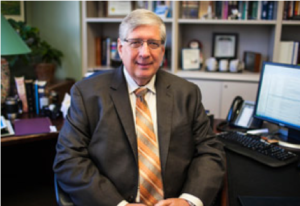This Big Change Spotlight features Herb Smith, President and CEO of Los Angeles Mission. The former VP of business and finance at Vanguard University, Herb has been with LA Mission since the early 1990s, serving as a director and a board member at various times. In his current role for more than a decade, he describes how he has followed his heart and has aimed to do what he loves: Helping people.
How did you get involved at Los Angeles Mission?
I originally started in the mid 1990s. I came to the Mission in search of a change of pace after my wife was diagnosed with breast cancer. I worked as the director for several years. I then left for another position but continued to work for the Mission as a member of the board of directors. Eventually, the new director resigned and they began a national search for a replacement. They ultimately asked me to take on the position again.
I resisted at first, but my wife reminded me: “You’ve been happier at the mission than anywhere else.” I came back and it was one of the best decisions I’ve made in my life.
I’d say what I did was follow my heart. I have always cared about helping people. Through all my career endeavors and personal experiences, it’s been important to me to help. I always say, I don’t need more commas in my bank account, but I’ll take more smiles. The genuine success of the people we serve at the Mission is what gets me up in the morning and keeps me going.
What is the three- to five-year plan for LA Mission?
LA Mission is a non-profit organization, of course. But for it to be as effective as it’s been for the last 82 years, it’s had to maintain a business approach – doing what makes sense fiscally and what creates the most impact for those we’re serving.
In line with this, in the next three to five years, we’ll be continuing to look at opportunities to better connect with people. We want to expand our mental health services and our women and family services. We want to partner with school districts in education, training, and support services to reach students who may be homeless who we may not know about. We’re also looking to acquire more property to add transitional housing for women and children.
Another area of focus is to do more with prisoner release programs – working with individuals in the system, identifying the source of their trauma, and getting them into a supportive environment and into our programs.
We’re also always looking to evolve with best practices. We’ve building on our bridge housing program. This is a model that reaches the population of people who may have a permanent housing option, but have a gap in time or logistics before they can access it. The goal is not to have them come to shelter and stay and stay, but to create steps for them to connect with that next solution. Another best practice is moving more toward case management – instead of providing a few nights of shelter, we’re really diving into what individuals need and connecting them with services that will turn their lives around.
What are the challenges you face in leading LA Mission?
As with any non-profit, there are always challenges to do more with less. There is always a balance of how to keep our doors open and how to fund growth. Right now, the LA Mission property needs updates and modification beyond cosmetics. There is also a need to expand our current capacity with one or two additional facilities. We want to broaden our service area outside the Skid Row area.
But as with any non-profit, a lot of our capacity depends on donors. We have a very generous donor base, for which we are grateful. We do get some dollars from federal sources, but, being a faith-based organization, there are challenges in accessing city and county funds that other organizations may be able to take advantage of.
What are the top reservations you hear from people or companies that are hesitant to get involved or donate?
There is a certain cynicism in our culture. There is fear of the unknown, fear of being taking advantage of. This is why I don’t try to convince people of anything, or try to sell them. If they have to be talked into something, then I don’t want their money. I tell them, come in and see what we do. This is a better way to explain the role of nonprofits and the role of the Mission.
It gets back to finding out what people are passionate about. If they are interested in changing society, then it’s a good fit. But everyone needs to follow their own passion and help the way they want to help. If they have other interests, they should look at other non-profits. There’s a lot of good organizations out there doing good work. There’s a place for everyone.
Watch for more Big Change Spotlights to come. To learn more, or to volunteer to be featured in an upcoming Spotlight, contact us.




Comments are closed.